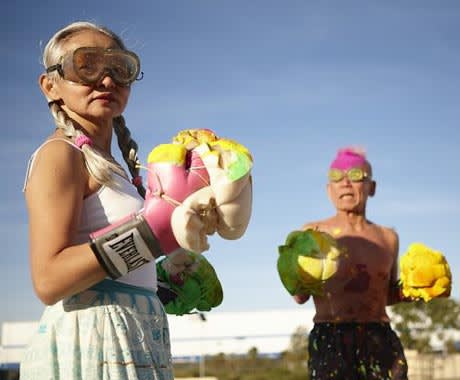The 'Boxer' and the 'Cutie' of this story are Ushio and Noriko Shinohara, Japanese ex-pat artists living in New York personifying the concept of the starving artist, struggling to pay bills and raise their child in one of the world's most expensive cities. This is the core conflict at the heart of Zachary Heinzerling's Oscar-nominated documentary. But it's the endearing warmth of its characters, notably Noriko herself, the devoted wife in the family, with which we connect most.
Through a combination of modern verite footage, interviews and stock footage, we learn about the unique love affair of Ushio and Noriko. Ushio, now age 80, was and still is a renowned pop artist who emerged in the '60s as a contemporary of Andy Warhol. Ushio's specialty was his sculpting strange motorcycles made entirely of recycled cardboard and large canvas artwork, painted in supremely theatrical fashion using boxing gloves embedded with pockets of paint. The sight of Ushio's strapping on boxing gloves and socking his canvas with paint is one of the film's visual delights.
As Ushio was being celebrated in Japan and the U.S. he attracted a much younger fan in Noriko, then a 19-year-old artist. A love affair blossomed over the next decade and thus began a 40+ year relationship. Thereafter, Ushio's rampant alcoholism fueled years of heated domestic conflict, and underneath that, the conflict from financial hardship and the pains of living paycheque to paycheque.
Some of the most heartfelt moments show Noriko and Ushio arguing over of the price of Ushio's artwork and the stress of making sales of his pieces in order to pay their past-due rent. Their son Alex, also a budding artist, and who appears to have taken to alcohol like his father, serves as a sad reminder of the effect of their tempestuous relationship.
The brief depictions of the NYC art scene are fascinating, and we can't help but want to see more of it. Whenever the Shinoharas do engage the outside world, Heinzerling is attentive in showing the power balance of the desperate Ushio and Noriko and the NYC gallery owners who curate the influential shows. The appearance of a Guggenheim curator looking for something of the Ushio's for the Museum adds great tension to the room. We desperately want him to succeed, and his failure to close the deal is heartbreaking.
Noriko's story, as wife, mother, homemaker and artist, eventually rises to the fore. We see her developing her own artwork, privately at first in her home journals and eventually in her own art show, the course of which forms the film's strong triumphant narrative arc.
(Mongrel Media)Through a combination of modern verite footage, interviews and stock footage, we learn about the unique love affair of Ushio and Noriko. Ushio, now age 80, was and still is a renowned pop artist who emerged in the '60s as a contemporary of Andy Warhol. Ushio's specialty was his sculpting strange motorcycles made entirely of recycled cardboard and large canvas artwork, painted in supremely theatrical fashion using boxing gloves embedded with pockets of paint. The sight of Ushio's strapping on boxing gloves and socking his canvas with paint is one of the film's visual delights.
As Ushio was being celebrated in Japan and the U.S. he attracted a much younger fan in Noriko, then a 19-year-old artist. A love affair blossomed over the next decade and thus began a 40+ year relationship. Thereafter, Ushio's rampant alcoholism fueled years of heated domestic conflict, and underneath that, the conflict from financial hardship and the pains of living paycheque to paycheque.
Some of the most heartfelt moments show Noriko and Ushio arguing over of the price of Ushio's artwork and the stress of making sales of his pieces in order to pay their past-due rent. Their son Alex, also a budding artist, and who appears to have taken to alcohol like his father, serves as a sad reminder of the effect of their tempestuous relationship.
The brief depictions of the NYC art scene are fascinating, and we can't help but want to see more of it. Whenever the Shinoharas do engage the outside world, Heinzerling is attentive in showing the power balance of the desperate Ushio and Noriko and the NYC gallery owners who curate the influential shows. The appearance of a Guggenheim curator looking for something of the Ushio's for the Museum adds great tension to the room. We desperately want him to succeed, and his failure to close the deal is heartbreaking.
Noriko's story, as wife, mother, homemaker and artist, eventually rises to the fore. We see her developing her own artwork, privately at first in her home journals and eventually in her own art show, the course of which forms the film's strong triumphant narrative arc.




